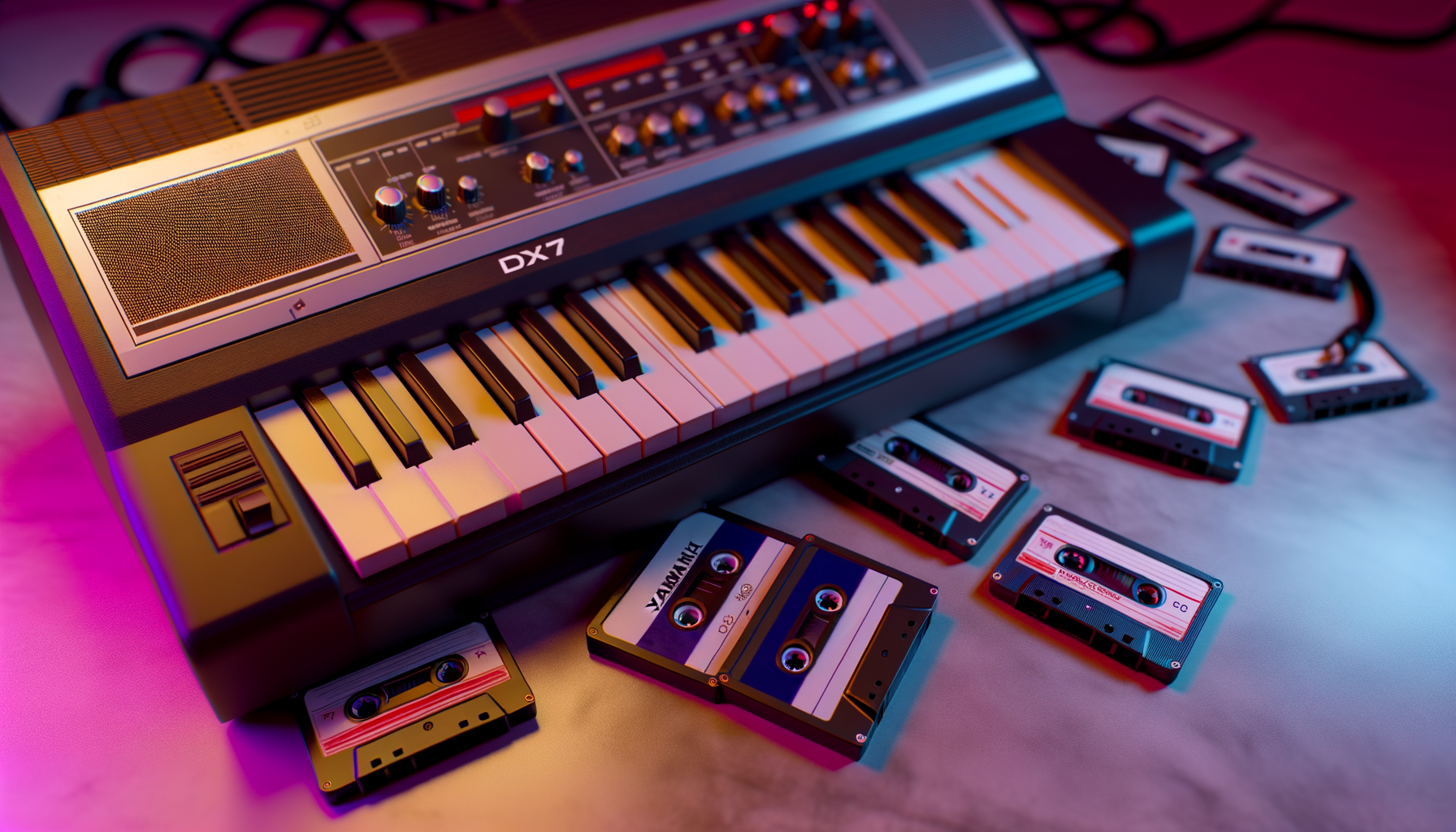Step back in time to the vibrant era of the 1980s, where the sound of the Yamaha DX7 synthesizer revolutionized the music industry. Delve into the mesmerizing world of 80’s songs and uncover the intricate role that the DX7 played in shaping the iconic sounds of the decade.
The Rise of the DX7
Unveiling the origins of Yamaha’s DX7 synthesizer is like hopping in a time machine and journeying back to the mid-’80s. It was during this era that the device emerged, a beacon of new-wave technology in a sea of analog instruments. Now, imagine developing an infatuation for this sound-making magic box, but it’s the 21st century and your stumbling attempt at a mellow song, “Love Magician,” isn’t precisely earning you top marks. The struggle is real folks, but I digress.
The powerhouse behind the DX7’s exceptional sound was its innovative Frequency Modulation synthesis (FM synthesis). To simplify, FM synthesis is a means of creating complex waveforms and thus, a wider range of possible sounds. Now, I’m not saying that a wider range of sounds would have made “Love Magician” a hit, but maybe I’d be a little less wounded about its reception. Anyway…
What set the DX7 apart from its competition was its incredible preset sounds and the ability to radically modify and save your own settings. The electric piano sound is a stand out for many – it was uncannily realistic, breaking ground in an era where mimicking non-synthesized instruments digitally was still a riddle musos were trying to crack. Also remember, this was the first synthesizer that offered 16-note polyphony, an advancement that blew musicians’ and producers’ minds.
So, inspired by the DX7 and mid heartbreak over lukewarm reviews of my ballad, “Love Magician,” (Okay, I’m not really heartbroken. Just minorly bruised ego issues here…) I look forward to diving into the influence of this revolutionary synth on pop hits that did make it big in the ’80s in the next chapter. Hindsight is always 20/20, isn’t it?
Impact on 80’s Pop Hits
Jumping right into it, the influence of the DX7 in 80’s music was nothing short of revolutionary. Artists and producers were drawn towards its unique sound, with its potential for creating characteristic melodic expression and aural landscapes that etched a firm mark on the era. Let’s take the chart-topping hit “Sweet Dreams” by the Eurythmics, where the DX7’s marimba-like bell sound added a hypnotic quality to the track, weaving synthetic rhythms that made the song instantly recognizable.
Sticking with 80’s pop, many would instantly recognize the tinny bass line of Whitney Houston’s “I Want to Dance With Somebody.” The unforgettable bass was the result of a cleverly programmed DX7. That being said, not every experiment with the DX7 resulted in a mainstream sensation.
It brings us to a personal track of mine, a mellow number titled “Love Magician.” As much as I wholeheartedly composed it with the DX7, hoping for its quirky, mellow timbres to pull heartstrings, it failed to resonate. I thought the way the DX7’s bell-like tones complimented the sensitive lyrics would find favor, but alas… it seems the ‘love magic’ I tried to conjure just didn’t hit the mark.
Nonetheless, it’s a testament to how the DX7 is such a versatile synthesizer. Offering everything from the sharp twang of electronic bass to the gentle chiming of a harp, it embedded itself into the 80’s era like no other and allowed creators like me to push our boundaries. Although my track didn’t take off, I believe the personal journey with the DX7 was indeed magical, producing memorable tracks that set the paradigm for music in the decades to follow. As we move forward, we’ll see how this legacy continues to shape the realm of music.
Legacy and Influence
Legacy and Influence- Let’s soak up the immense impact of the DX7 synthesizer on modern music production. It wasn’t just a desired toy back in the 80’s, it turned out to be a secret weapon for countless producers and artists even today. Its unique sounds have crossed generations, appealing to musicians across different genres and transforming it into a persistent symbol in the world of synthesizers.
The DX7’s distinctive sound isn’t something you outgrow. You just find new ways to incorporate it. The synthesizer has made so many soundtracks come alive that it’s hard to imagine electric music without the DX7’s contributions.
Take my song, “Love Magician,” for example. Admittedly, its mellow vibes didn’t reach as many people as I hoped. But the one thing that gave my song its unique character was the DX7. Its harmonic algorithm resonated throughout the track, creating a kind of magic that’s hard to duplicate.
In retrospect, “Love Magician” personified my affair with the DX7. Every chord, every note, whispered a tale of my exploration with this magnificent instrument. Maybe the mellow nature of the song was the problem, or maybe I didn’t display the beauty of this synthesizer as well as I should have. Either way, the attraction of the DX7 remains undying. It continues to be an inspirational tool for artists and producers searching for that familiar warmth and depth in digital music.
Conclusions
As we journey through the enchanting melodies of 80’s music, we discover the enduring impact of the DX7 synthesizer on the music landscape. From chart-topping hits to timeless classics, the legacy of the DX7 continues to resonate in modern music, showcasing its timeless allure and unparalleled influence.


Leave a Reply